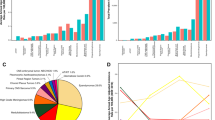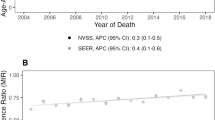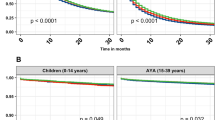Abstract
Purpose
Population-based cancer statistics, including histology-specific incidence, prevalence, and survival are essential to evaluating the total burden due to disease in a population. The National Cancer Institute’s (NCI) Comprehensive Oncology Network Evaluating Rare CNS Tumors (NCI-CONNECT) was developed to better understand tumor biology and patient outcomes for 12 selected brain and other central nervous system (CNS) tumor histologies that are rare in adults to improve approaches to care and treatment. The aim of this study was to determine the incidence, prevalence, and survival of these selected rare histologies.
Methods
Data from the Central Brain Tumor Registry of the United States (CBTRUS) from 2000 to 2014 were used to calculate average annual age-adjusted incidence rates (AAIR) per 100,000 population overall and by sex, race, ethnicity, and age. NCI’s Surveillance, Epidemiology and End Results (SEER) data were used to calculate relative survival (RS) estimates. Point prevalence for 2014 was estimated using annual age-specific incidence and survival from CBTRUS and SEER, respectively.
Results
Overall AAIR was 1.47 per 100,000 for all 12 rare histologies combined, with the highest histology-specific incidence in oligodendrogliomas (AAIR = 0.40/100,000). Overall, most histologies were more common in males, adults (age 40 + ), Whites, and non-Hispanics. Ependymomas were the most prevalent histology at 4.11 per 100,000; followed by oligodendrogliomas at 3.68 per 100,000. Relative survival at 1-, 5-, and 10-years was 82.3%, 64.0%, and 55.4%, respectively for all 12 selected brain and other CNS tumor types combined. Ependymomas had the highest RS (1-year = 94.2%, 5-year = 83.9%, 10-year = 78.6%) and gliosarcomas had the lowest relative survival rate (1-year = 42.5%, 5-year = 5.6%, 10-year = 2.9%) at all three time points.
Conclusions
Incidence and prevalence of these rare brain and other CNS tumor histologies have not been previously reported. Along with survival, these data provide a statistical foundation to understand the impact of these cancers and provide important disease-specific data for the design of prospective clinical trials.





Similar content being viewed by others
References
Ostrom QT, Gittleman H, Truitt G, Boscia A, Kruchko C, Barnholtz-Sloan JS (2018) CBTRUS statistical report: primary brain and other central nervous system tumors diagnosed in the United States in 2011–2015. Neuro Oncol 20:iv1–iv86. https://doi.org/10.1093/neuonc/noy131
Louis DNOH, Wiestler OD, Cavanee WK (eds) (2016) WHO classification of tumours of the central nervous system. International Agency for Research on Cancer, Lyon, France
Surveillance E, and End Results (SEER) Program (2000–2014) SEER*Stat Database: Incidence - SEER 18 Regs Research Data + Hurricane Katrina Impacted Louisiana Cases, Nov 2016 Sub (2000–2014) <Katrina/Rita Population Adjustment> In: National Cancer Institute D, Surveillance Research Program (ed).
Fay MP (1999) Approximate confidence intervals for rate ratios from directly standardized rates with sparse data. Commun Stat Theory Methods 28:2141–2160. https://doi.org/10.1080/03610929908832411
Fay MP, Tiwari RC, Feuer EJ, Zhaohui Z (2006) Estimating average annual percent change for disease rates without assuming constant change. Biometrics 62:847–854
Surveillance Research Program National Cancer Institute SEER*Stat software. 8.3.5 edn.
Zhang AS, Ostrom QT, Kruchko C, Rogers L, Peereboom DM, Barnholtz-Sloan JS (2017) Complete prevalence of malignant primary brain tumors registry data in the United States compared with other common cancers, 2010. Neuro Oncol 19:726–735. https://doi.org/10.1093/neuonc/now252
R Core Team (2018) R: a language and environment for statistical computing. R Foundation for Statistical Computing, Vienna
Ostrom QT, Chen Y, MdB P, Ondracek A, Farah P, Gittleman H, Wolinsky Y, Kruchko C, Cohen ML, Brat DJ, Barnholtz-Sloan JS (2014) The descriptive epidemiology of atypical teratoid/rhabdoid tumors in the United States, 2001–2010. Neuro Oncol 16:1392–1399. https://doi.org/10.1093/neuonc/nou090
von Hoff K, Hinkes B, Dannenmann-Stern E, von Bueren AO, Warmuth-Metz M, Soerensen N, Emser A, Zwiener I, Schlegel PG, Kuehl J, Fruhwald MC, Kortmann RD, Pietsch T, Rutkowski S (2011) Frequency, risk-factors and survival of children with atypical teratoid rhabdoid tumors (AT/RT) of the CNS diagnosed between 1988 and 2004, and registered to the German HIT database. Pediatr Blood Cancer 57:978–985. https://doi.org/10.1002/pbc.23236
Woehrer A, Slavc I, Waldhoer T, Heinzl H, Zielonke N, Czech T, Benesch M, Hainfellner JA, Haberler C (2010) Incidence of atypical teratoid/rhabdoid tumors in children: a population-based study by the Austrian Brain Tumor Registry, 1996–2006. Cancer 116:5725–5732. https://doi.org/10.1002/cncr.25540
Reyes-Botero G, Mokhtari K, Martin-Duverneuil N, Delattre JY, Laigle-Donadey F (2012) Adult brainstem gliomas. Oncologist 17:388–397. https://doi.org/10.1634/theoncologist.2011-0335
Davis ME (2018) Epidemiology and overview of gliomas. Semin Oncol Nurs 34:420–429. https://doi.org/10.1016/j.soncn.2018.10.001
Freeman CR, Farmer JP (1998) Pediatric brain stem gliomas: a review. Int J Radiat Oncol Biol Phys 40:265–271
Tasic G, Repac N, Nikolic I, Bogosavljevic V, Scepanovic V, Janicijevic A, Eric-Nikolic A, Rasulic L (2017) Adult brainstem gliomas: retrospective analysis of 51 patients. Turk Neurosurg 27:558–562. https://doi.org/10.5137/1019-5149.Jtn.16488-15.1
Wolff JE, Sajedi M, Brant R, Coppes MJ, Egeler RM (2002) Choroid plexus tumours. Br J Cancer 87:1086–1091. https://doi.org/10.1038/sj.bjc.6600609
Dudley RW, Torok MR, Gallegos D, Liu AK, Handler MH, Hankinson TC (2015) Pediatric choroid plexus tumors: epidemiology, treatments, and outcome analysis on 202 children from the SEER database. J Neurooncol 121:201–207. https://doi.org/10.1007/s11060-014-1628-6
Rickert CH, Paulus W (2001) Tumors of the choroid plexus. Microsc Res Tech 52:104–111. https://doi.org/10.1002/1097-0029(20010101)52:1%3c104:Aid-jemt12%3e3.0.Co;2-3
Kshettry VR, Ostrom QT, Kruchko C, Al-Mefty O, Barnett GH, Barnholtz-Sloan JS (2015) Descriptive epidemiology of World Health Organization grades II and III intracranial meningiomas in the United States. Neuro Oncol 17:1166–1173. https://doi.org/10.1093/neuonc/nov069
Harter PN, Braun Y, Plate KH (2017) Classification of meningiomas-advances and controversies. Chin Clin Oncol 6:S2. https://doi.org/10.21037/cco.2017.05.02
Wiemels J, Wrensch M, Claus EB (2010) Epidemiology and etiology of meningioma. J Neurooncol 99:307–314. https://doi.org/10.1007/s11060-010-0386-3
Dolecek TA, Dressler EV, Thakkar JP, Liu M, Al-Qaisi A, Villano JL (2015) Epidemiology of meningiomas post-Public Law 107–206: the Benign Brain Tumor Cancer Registries Amendment Act. Cancer 121:2400–2410. https://doi.org/10.1002/cncr.29379
Greenfield JP, Castaneda Heredia A, George E, Kieran MW, Morales La Madrid A (2016) Gliomatosis cerebri: a consensus summary report from the First International Gliomatosis cerebri Group Meeting, March 26–27, 2015, Paris, France. Pediatr Blood Cancer 63:2072–2077. https://doi.org/10.1002/pbc.26169
Bruna J, Velasco R (2010) Gliomatosis cerebri. Neurologia 25:143–147
Armstrong GT, Phillips PC, Rorke-Adams LB, Judkins AR, Localio AR, Fisher MJ (2006) Gliomatosis cerebri: 20 years of experience at the Children's Hospital of Philadelphia. Cancer 107:1597–1606. https://doi.org/10.1002/cncr.22210
Chan MY, Teo WY, Seow WT, Tan AM (2007) Epidemiology, management and treatment outcome of medulloblastoma in singapore. Ann Acad Med Singapore 36:314–318
Curran EK, Sainani KL, Le GM, Propp JM, Fisher PG (2009) Gender affects survival for medulloblastoma only in older children and adults: a study from the Surveillance Epidemiology and End Results Registry. Pediatr Blood Cancer 52:60–64. https://doi.org/10.1002/pbc.21832
Smoll NR, Drummond KJ (2012) The incidence of medulloblastomas and primitive neurectodermal tumours in adults and children. J Clin Neurosci 19:1541–1544. https://doi.org/10.1016/j.jocn.2012.04.009
Farwell JR, Dohrmann GJ, Flannery JT (1984) Medulloblastoma in childhood: an epidemiological study. J Neurosurg 61:657–664. https://doi.org/10.3171/jns.1984.61.4.0657
McNeil DE, Cote TR, Clegg L, Rorke LB (2002) Incidence and trends in pediatric malignancies medulloblastoma/primitive neuroectodermal tumor: a SEER update. Surveillance Epidemiology and End Results. Med Pediatr Oncol 39:190–194. https://doi.org/10.1002/mpo.10121
Khanna V, Achey RL, Ostrom QT, Block-Beach H, Kruchko C, Barnholtz-Sloan JS, de Blank PM (2017) Incidence and survival trends for medulloblastomas in the United States from 2001 to 2013. J Neurooncol 135:433–441. https://doi.org/10.1007/s11060-017-2594-6
Archer TC, Mahoney EL, Pomeroy SL (2017) Medulloblastoma: molecular classification-based personal therapeutics. Neurotherapeutics 14:265–273. https://doi.org/10.1007/s13311-017-0526-y
Becker LE, Hinton D (1983) Primitive neuroectodermal tumors of the central nervous system. Hum Pathol 14:538–550
Van den Bent MJ, Reni M, Gatta G, Vecht C (2008) Oligodendroglioma. Crit Rev Oncol Hematol 66:262–272. https://doi.org/10.1016/j.critrevonc.2007.11.007
Achey RL, Khanna V, Ostrom QT, Kruchko C, Barnholtz-Sloan JS (2017) Incidence and survival trends in oligodendrogliomas and anaplastic oligodendrogliomas in the United States from 2000 to 2013: a CBTRUS Report. J Neurooncol 133:17–25. https://doi.org/10.1007/s11060-017-2414-z
Lau CS, Mahendraraj K, Chamberlain RS (2017) Oligodendrogliomas in pediatric and adult patients: an outcome-based study from the Surveillance, Epidemiology, and End Result database. Cancer Manag Res 9:159–166. https://doi.org/10.2147/cmar.s117799
Goel NJ, Abdullah KG, Lang SS (2018) Outcomes and prognostic factors in pediatric oligodendroglioma: a population-based study. Pediatr Neurosurg 53:24–35. https://doi.org/10.1159/000481458
Zaazoue MA, Goumnerova LC (2016) Pineal region tumors: a simplified management scheme. Childs Nerv Syst 32:2041–2045. https://doi.org/10.1007/s00381-016-3157-4
Al-Hussaini M, Sultan I, Abuirmileh N, Jaradat I, Qaddoumi I (2009) Pineal gland tumors: experience from the SEER database. J Neurooncol 94:351–358. https://doi.org/10.1007/s11060-009-9881-9
Ida CM, Rodriguez FJ, Burger PC, Caron AA, Jenkins SM, Spears GM, Aranguren DL, Lachance DH, Giannini C (2015) Pleomorphic xanthoastrocytoma: natural history and long-term follow-up. Brain Pathol 25:575–586. https://doi.org/10.1111/bpa.12217
Rutkowski MJ, Oh T, Niflioglu GG, Safaee M, Tihan T, Parsa AT (2016) Pleomorphic xanthoastrocytoma with anaplastic features: retrospective case series. World Neurosurg 95:368–374. https://doi.org/10.1016/j.wneu.2016.07.068
Wu J, Armstrong TS, Gilbert MR (2016) Biology and management of ependymomas. Neuro Oncol 18:902–913. https://doi.org/10.1093/neuonc/now016
Gerstner ER, Pajtler KW (2018) Ependymoma. Semin Neurol 38:104–111. https://doi.org/10.1055/s-0038-1636503
Vitanza NA, Partap S (2016) Pediatric ependymoma. J Child Neurol 31:1354–1366. https://doi.org/10.1177/0883073815610428
Funding
Funding for CBTRUS has been provided by the Centers for Disease Control and Prevention (CDC) under Contract No. 2016-M-9030, the American Brain Tumor Association, The Sontag Foundation, Novocure, AbbVie, the Musella Foundation, National Brain Tumor Society, the Zelda Dorin Tetenbaum Memorial Fund, the National Cancer Institute (NCI) under Contract No. HHSN261201800176P, the Uncle Kory Foundation, and from private and in kind donations. The findings and conclusions in this report are those of the authors and do not necessarily represent the official position of the CDC or NCI. QTO is supported by a Research Training Grant from the Cancer Prevention and Research Institute of Texas (CPRIT; RP160097T).
Author information
Authors and Affiliations
Corresponding author
Ethics declarations
Conflict of interest
There are no conflicts of interest to disclose.
Ethical approval
This article does not contain any studies with human participants or animals performed by any of the authors. This study was approved as an exempt study by the University Hospitals Cleveland Medical Center Institutional Review Board.
Informed consent
This was a retrospective study using de-identified national cancer registries. Thus, formal consent was not required.
Additional information
Publisher's Note
Springer Nature remains neutral with regard to jurisdictional claims in published maps and institutional affiliations.
Electronic supplementary material
Below is the link to the electronic supplementary material.
Rights and permissions
About this article
Cite this article
Truitt, G., Gittleman, H., Leece, R. et al. Partnership for defining the impact of 12 selected rare CNS tumors: a report from the CBTRUS and the NCI-CONNECT. J Neurooncol 144, 53–63 (2019). https://doi.org/10.1007/s11060-019-03215-x
Received:
Accepted:
Published:
Issue Date:
DOI: https://doi.org/10.1007/s11060-019-03215-x




